The AMD Radeon R9 290X Review
by Ryan Smith on October 24, 2013 12:01 AM EST- Posted in
- GPUs
- AMD
- Radeon
- Hawaii
- Radeon 200
Company of Heroes 2
Our second benchmark in our benchmark suite is Relic Games’ Company of Heroes 2, the developer’s World War II Eastern Front themed RTS. For Company of Heroes 2 Relic was kind enough to put together a very strenuous built-in benchmark that was captured from one of the most demanding, snow-bound maps in the game, giving us a great look at CoH2’s performance at its worst. Consequently if a card can do well here then it should have no trouble throughout the rest of the game.
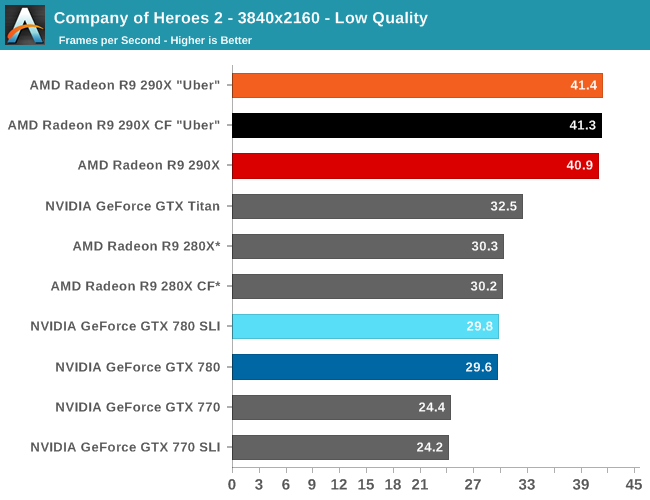
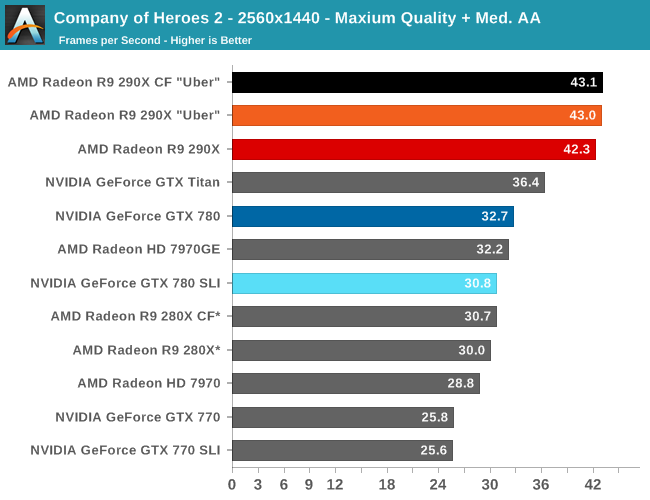
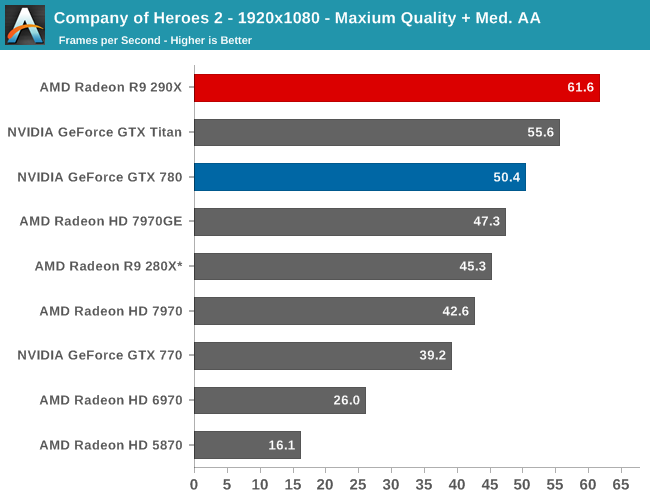
Our first strategy game is also our first game that is flat out AFR incompatible, and as a result the only way to get the best performance out of Company of Heroes 2 is with the fastest single-GPU card available. To that end this is a very clear victory for the 290X, and in fact will be the largest lead for the 290X of all of our benchmarks. At 2560 it’s a full 29% faster than the GTX 780, which all but puts the 290X in a class of its own. This game also shows some of the greatest gains for the 290X over the 280X, with the 290X surpassing its Tahti based predecessor by an equally chart topping 41%. It’s not clear what it is at this time that Company of Heroes 2 loves about 290X in particular, but as far as this game is concerned AMD has put together an architecture that maps well to the game’s needs.
Briefly, because of a lack of AFR compatibility 4K is only barely attainable with any kind of GPU setup. In fact we’re only throwing in the scale-less SLI/CF numbers to showcase that fact. We had to dial down our quality settings to Low on CoH2 in order to get a framerate above 30fps; even though we can be more liberal about playable framerates on strategy games, there still needs to be a cutoff for average framerates around that point. As a result 280X, GTX Titan, and 290X are the only cards to make that cutoff, with 290X being the clear winner. But the loss in quality to make 4K achievable is hardly worth the cost.
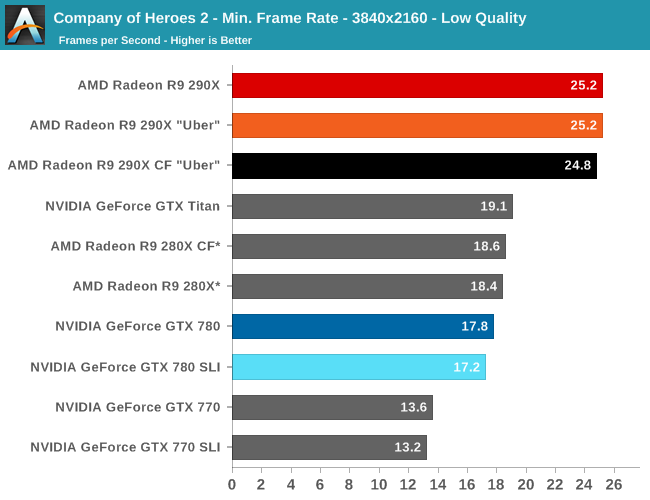
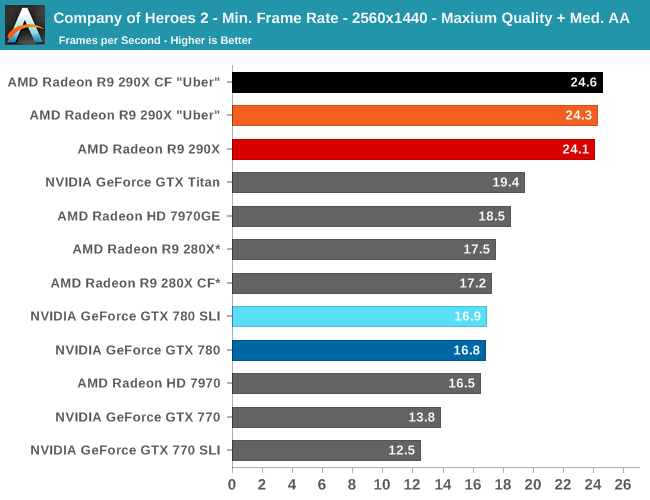

Moving on to minimum framerates, we see that at its most stressful points that nothing, not even 290X, can keep its minimums above 30fps. For a strategy game this is bearable, but we certainly wouldn’t mind more performance. AMD will be pleased though, as their performance advantage over the GTX 780 is only further extended here; a 29% average performance advantage becomes a 43% minimum performance advantage at 2560.
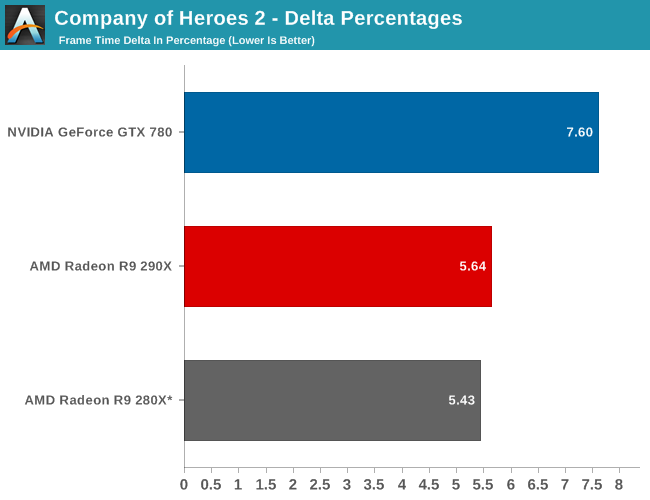
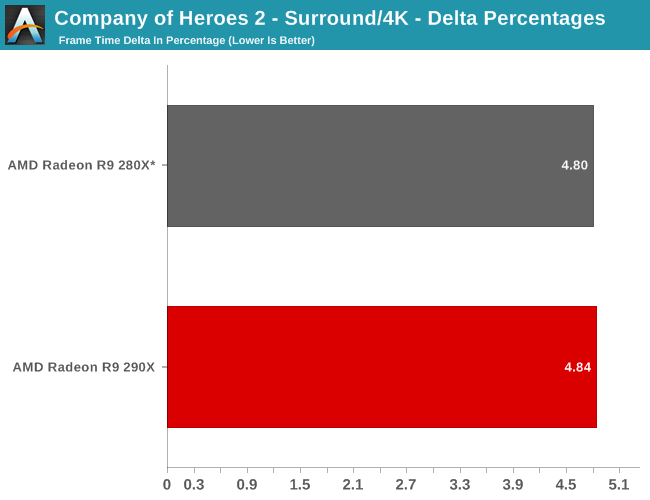
Finally, while we don’t see any performance advantages from AFR on this game we did run our FCAT benchmarks anyhow to quickly capture the delta percentages. Company of Heroes 2 has a higher than average variance even among single cards, which results in deltas being above 5%. The difference between 5% and 7% is not going to be too significant in practice here, but along with AMD’s performance advantage they do have slightly more consistent frame times than the GTX 780. Though in both the case of the 280X and the 290X we’re looking at what are essentially the same deltas, so while the 290X improves on framerates versus the 280X, it doesn’t bring with it any improvements in frame time consistency.










396 Comments
View All Comments
Sandcat - Friday, October 25, 2013 - link
That depends on what you define as 'acceptable frame rates'. Yeah, you do need a $500 card if you have a high refresh rate monitor and use it for 3d games, or just improved smoothness in non-3d games. A single 780 with my brothers' 144hz Asus monitor is required to get ~90 fps (i7-930 @ 4.0) in BF3 on Ultra with MSAA.The 290x almost requires liduid...the noise is offensive. Kudos to those with the equipment, but really, AMD cheaped out on the cooler in order to hit the price point. Good move, imho, but too loud for me.
hoboville - Thursday, October 24, 2013 - link
Yup, and it's hot. It will be worth buying once the manufacturers can add their own coolers and heat pipes.AMD has always been slower at lower res, but better in the 3x1080p to 6x1080p arena. They have always aimed for high-bandwidth memory, which is always performs better at high res. This is good for you as a buyer because it means you'll get better scaling at high res. It's essentially forward-looking tech, which is good for those who will be upgrading monitors in the new few years when 1440p IPS starts to be more affordable. At low res the bottleneck isn't RAM, but computer power. Regardless, buying a Titan / 780 / 290X for anything less than 1440p is silly, you'll be way past the 60-70 fps human eye limit anyway.
eddieveenstra - Sunday, October 27, 2013 - link
Maybe 60-70fps is the limit. but at 120Hz 60FPS will give noticable lag. 75 is about the minimum. That or i'm having eagle eyes. The 780gtx still dips in the low framerates at 120Hz (1920x1080). So the whole debate about titan or 780 being overkill @1080P is just nonsense. (780gtx 120Hz gamer here)hoboville - Sunday, October 27, 2013 - link
That really depends a lot on your monitor. When they talked about Gsync and frame lag and smoothness, they mentioned when FPS doesn't exactly match the refresh rate you get latency and bad frame timing. That you have this problem with a 120 Hz monitor is no surprise as at anything less than 120 FPS you'll see some form of stuttering. When we talk about FPS > refresh rate then you won't notice this. At home I use a 2048x1152 @ 60 Hz and beyond 60 FPS all the extra frames are dropped, where as in your case you'll have some frames "hang" when you are getting less than 120 FPS, because the frames have to "sit" on the screen for an interval until the next one is displayed. This appears to be stuttering, and you need to get a higher FPS from the game in order for the frame delivery to appear smoother. This is because apparent delay decreases as a ratio of [delivered frames (FPS) / monitor refresh speed]. Once the ratio is small enough, you can no longer detect apparent delay. In essence 120 Hz was a bad idea, unless you get Gsync (which means a new monitor).Get a good 1440p IPS at 60 Hz and you won't have that problem, and the image fidelity will make you wonder why you ever bought a monitor with 56% of 1440p pixels in the first place...
eddieveenstra - Sunday, October 27, 2013 - link
To be honnest. I would never think about going back to 60Hz. I love 120Hz but don't know a thing about IPS monitors. Thanks for the response....Just checked it and that sounds good. When becoming more affordable i will start thinking about that. Seems like the IPS monitors are better with colors and have less blur@60Hz than TN. link:http://en.wikipedia.org/wiki/IPS_panel
Spunjji - Friday, October 25, 2013 - link
Step 1) Take data irrespective of different collection methods.Step 2) Perform average of data.
Step 3) Completely useless results!
Congratulations, sir; you have broken Science.
nutingut - Saturday, October 26, 2013 - link
But who cares if you can play at 90 vs 100 fps?MousE007 - Thursday, October 24, 2013 - link
Very true, but remember, the only reason nvidia prices their cards where they are is because they could. (Eg Intel CPUs v AMD) Having said that, I truly welcome the competition as it makes it better for all of us, regardless of which side of the fence you sit.valkyrie743 - Thursday, October 24, 2013 - link
the card runs at 95C and sucks power like no tomorrow. only only beats the 780 by a very little. does not overclock well.http://www.youtube.com/watch?v=-lZ3Z6Niir4
and
http://www.youtube.com/watch?v=3OHKWMgBhvA
http://www.overclock3d.net/reviews/gpu_displays/am...
i like his review. its pure honest and shows the facts. im not a nvidia fanboy nore am i a amd fanboy. but ill take nvidia right how over amd.
i do like how this card is priced and the performance for the price. makes the titan not worth 1000 bucks (or the 850 bucks it goes used on forums) but as for the 780. if you get a non reference 780. it will be faster than the 290x and put out LESS heat and LESS noise. as well as use less power.
plus gtx 780 TI is coming out in mid November which will probably cut the cost of the current 780 too 550 and and this card would be probably aorund 600 and beat this card even more.
jljaynes - Friday, October 25, 2013 - link
you say the review sticks with the facts - he starts off talking about how ugly the card is so it needs to beat a titan. and then the next sentence he says the R9-290X will cost $699.he sure seems to stick with the facts.